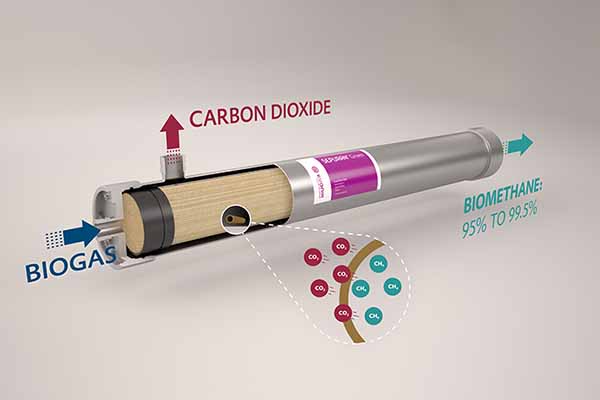Compressed Bio-gas (CBG) is the fuel of future to run vehicles, cook, and even generate power. But its faster adoption would be directly dependent on its cost and purity. To make sure that CBG is the fuel of choice, it is important to work reverse from the way it is purified.
Bio-gas is a by-product from the waste/bio-mass sources such as agricultural waste, cattle dung, sugarcane press mud, municipal solid waste, sewage treatment plants and among others. The degeneration of organic waste is acted upon by anaerobic bacteria that releases bio-gas as a by-product. However, this bio-gas is not in the pure form and needs to be purified to remove hydrogen sulphide (H2S), carbon dioxide (CO2), and water vapours, and separate pure bio-methane from it. The presence of CO2 reduces Bio-gas’s calorific value, which is the quantity of heat that the fuel can produce in combustion, and H2S is a corrosive gas. Therefore, it becomes imperative to purify the bio-gas before it is fed into the National Gas Grid for usage.
Membrane technology, is one of the most effective ways to purify CBG, and also a sustainable solution. The membrane separation process involves no chemicals, no water wastage, and emits no harmful gases into the environment. The biogas that comes from plants is first pre-dried and treated with active carbon. Following which, it becomes a pre-treated gas that is compressed to 10-20 bars ready for the membrane separation process.
How does Membrane Technology works?
In this technology, the principle at work is simple yet sophisticated. It revolves around the size of gas molecules and its solubility in polymers. The non-purified biogas is made to pass through at high pressure from one of the membranes. These membranes are hollow fibres bundled together and are permeable to carbon dioxide, water and ammonia. Since the molecules of carbon dioxide are smaller than the molecules of methane molecules and soluble in polymer, therefore they pass through the micropores of the membranes faster. Even hydrogen sulphide and oxygen permeate through the membranes but to some extent only. Nitrogen and methane molecules pass only at a very low extent. Leaving superior quality bio-methane recovery at the end of the membrane.
Key Benefits of Membrane Technology in CBG production
Low maintenance cost
While getting high purified CBG is one critical aspect, the other is to keep it economical to make it a viable alternative for industries. And to achieve that, it is important to have reliable long-lasting solution as well as low maintenance cost of the entire purifying process. In this regard, membrane technology have advantages compared to the other conventional processes of biogas upgradation and purification.
Membrane technology has significantly low maintenance cost and a more sustainable process. The process requires minimalistic heat or energy, and does not require usage of chemicals. In addition to this, it also does not lead to water wastage and cost towards setting up of waste water treatment plants.
In the entire purifying process via membrane separation, pre-treatment is crucial step, maintenance shows up when one encounters membrane fouling. In case, if Membrane fouling happens because of the contaminants, it can simply be treated via membrane cleaning through flushing, or chemical cleaning, and/or any permutation of these methods could be used. Other than this, there is no form of maintenance required for this purifying technology. Hence, significantly bringing down costs related to maintenance and running of the process.
Zero emissions
Membrane technology is sustainable and an environmental-friendly process, and does not release or use harmful chemicals in treating the biogas for commercial usage. The technology’s consumption of heat or energy or water, as well as usage of chemicals is close to nil and therefore, allows one to boost ecological footprints.
Flexible and easily scalable
Under the membrane technology, the production of purified CBG can be easily scaled up or down as per the requirement and industrial purpose. This is possible as it is not dependent on additional materials such as chemicals and water in the treatment. Instead, the same amounts of membranes can help increase or decrease production of purified CBG. Hence, giving you the flexibility to adjust as per the need.
Crucial for CBG acceptance in Energy sector
CBG is already being used in energy sector to replace carbon-heavy fossil fuels for desalination applications. The Ministry of Petrochemicals and Natural Gas (MoPNG) along with Sustainable Alternative Towards Affordable Transportation (SATAT) has been working towards making CBG the fuel for today as part of its overall agenda to push renewable energy. Therefore, the role of membrane technology is crucial in faster adoption of CBG in the country.
Evonik’s SEPURAN® Green membranes
Evonik India offers innovative hollow-fiber membranes under its brand SEPURAN® Green membranes for highly efficient biogas separation. The membranes are economical, easy-to-operate and modular by nature, and require no chemical or drying stage, and minimal space and almost no installation time altogether.
With more than 700 references worldwide, the benefits are manifold with SEPURAN® Green, when compared to traditional technologies for biogas upgradation and enrichment.
- Best price performance of all membrane systems
- High methane yield of up to >99 % and high purities >99% (patented 3-stage process)
- Highest energy efficiency (~ 0.2 kWel/Nm3crude biogas)
- Easy to operate, little maintenance –easy start & stop
- No chemical use and no waste water
- No spare parts needed, little maintenance
- Easy to scale up –containerized system
- Biomethane provided at system pressure, dry and in pipeline specifications
















